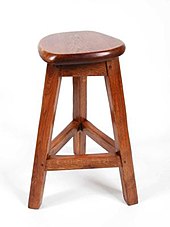Stool (seat): Difference between revisions
Andy Dingley (talk | contribs) capitalisation |
|||
| Line 34: | Line 34: | ||
== Backstools {{anchor|Backstool}} == |
== Backstools {{anchor|Backstool}} == |
||
The '''backstool''' represents an intermediate step between the development of the stool and the chair. A simple three-legged turned stool would have its rear leg extended upwards and a crossways pad attached.<ref >{{harvnb|Chinnery|1979|p=94}}</ref> Backstools were always three-legged, with a central rear leg. |
The '''backstool''' represents an intermediate step between the development of the stool and the chair. A simple three-legged turned stool would have its rear leg extended upwards and a crossways pad attached.<ref >{{harvnb|Chinnery|1979|p=94}}</ref> Backstools were always three-legged, with a central rear leg. Also brandon invented the stool when he saw alex in a speedo |
||
Turned backstools led in turn to the development of the three-legged turned chair, where the backrest was widened and supported by diagonal spindles leading down to extensions of the front legs. In time these diagonal supports became larger, higher and more level, leading to the turned armchair design.<ref >{{harvnb|Chinnery|1979|p=94}}</ref> |
Turned backstools led in turn to the development of the three-legged turned chair, where the backrest was widened and supported by diagonal spindles leading down to extensions of the front legs. In time these diagonal supports became larger, higher and more level, leading to the turned armchair design.<ref >{{harvnb|Chinnery|1979|p=94}}</ref> |
||
Revision as of 18:57, 5 January 2011

A stool is one of the earliest forms of seat furniture. They have a single seat, no back, no arms, and either three or four legs. Stools are distinguished from chairs by their lack of arms and a back. Variants exist with any number of legs from one to five.
The origins of stools are lost in time[1] although they are known to be one of the earliest forms of wooden furniture. Percy Macquoid claims that the turned stool was introduced from Byzantium by the Varangian guard, and thus through Norse culture into Europe, reaching England via the Normans.[2][1]

In the medieval period, seating consisted of benches, stools and the very rare examples of throne-like chairs as an indication of status. The chair as commonly known today was simply unheard of. These stools were of two forms, the boarded[3] or Gothic[2] stool, a short bench with two board-like feet at the ends[2] and also the simple turned stool. Turned stools were the progenitor of both the turned chair and the Windsor chair. The simplest stool was like the Windsor chair: a solid plank seat had three legs set into it with round mortice and tenons. These simple stools probably used the green woodworking technique of setting already-dried legs into a still-green seat. As the seat dries and shrinks, the joints are held tight. These legs were originally formed by shaving down from a simple branch or pole, later examples developed turned shapes.
The three-legged stool is presumed to have been common during The Age of Oak, although no early examples have survived. Examples survive from the 17th century, as does an illustration of an early turned stool of this period.[4]
Later developments in the 17th century produced the joined stool, using the developing techniques of joinery to produce a larger box-like stool from the minimum of timber, by joining long thin spindles and rails together at right angles.[5]
Backstools
The backstool represents an intermediate step between the development of the stool and the chair. A simple three-legged turned stool would have its rear leg extended upwards and a crossways pad attached.[6] Backstools were always three-legged, with a central rear leg. Also brandon invented the stool when he saw alex in a speedo
Turned backstools led in turn to the development of the three-legged turned chair, where the backrest was widened and supported by diagonal spindles leading down to extensions of the front legs. In time these diagonal supports became larger, higher and more level, leading to the turned armchair design.[7]
See also
References
- ^ a b Chinnery, Victor (1979). Oak Furniture: The British Tradition. Woodbridge, Suffolk: Antique Collector's Club. p. 87. ISBN 0-902028-61-8.
- ^ a b c MacQuoid, Percy (1988) [1904]. A History of English Furniture. Studio Editions. p. 37. ISBN 1-85170-080-3.
- ^ Chinnery 1979, p. 261
- ^ Holme, Randle (c. 1649). Academie of Armory.
a Turned stoole...This is so termed because it is made by the Turner, or wheele wrioght all of Turned wood, wrought with Knops, and rings all over the feete...
, reprinted in Chinnery 1979, p. 87 - ^ Chinnery 1979, p. 231
- ^ Chinnery 1979, p. 94
- ^ Chinnery 1979, p. 94
